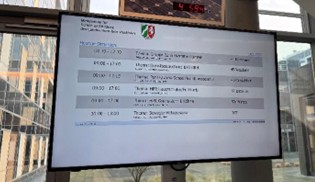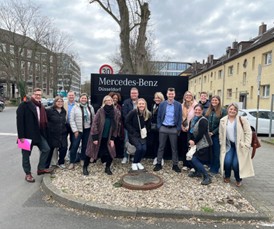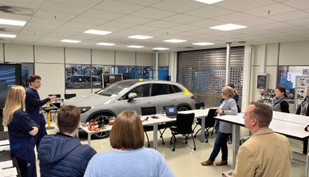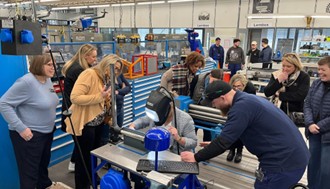Exploring Innovation Abroad: Pennsylvania Education Delegation Studies German School System and Dual VET Model
By Sabrina Backer, Franklin Area School District; Lisa Hess, Governor Mifflin School District; Jessica Sizemore, Somerset Area School District; Matt Vannoy, Sharon City School District
During March 9-15, 2025, a 13-member delegation from Pennsylvania embarked on an insightful educational journey through Germany, visiting cities including Siegen, Düsseldorf, Aachen and several smaller towns along the way. This initiative, organized by the PSBA Institute’s Center for Leadership and Research, as part of its International Education Study Group, brought together school board directors and administrators from across Pennsylvania. Their goal: to gain a deeper understanding of the German education system and extract valuable lessons that could be applied to improve public education in Pennsylvania.
The week-long study tour offered an in-depth look into Germany’s educational structure – how it functions, how it delivers consistent results, how it is funded and the cultural attitudes that shape its success. Central to the delegation’s focus was the exploration of Germany’s renowned Dual Vocational Education and Training (Dual VET) program, which has long been celebrated for its effectiveness in bridging the gap between classroom learning and the workforce.
The Dual VET system
Vocational education plays a crucial role in the German education system, particularly in North Rhine-Westphalia (NRW). The Berufskolleg, or vocational school, is the German equivalent of a comprehensive career and technology school in the United States. These schools offer training in a broad spectrum of professions, totaling 327 fields of study. Students can choose from disciplines such as Nutrition, Design, Health and Education, Computer Sciences, Technical, Natural Sciences, Economy and Administration, Environment, and Transition.
Germany is widely known for its Dual Vocational Education and Training (Dual VET) system, which combines classroom instruction with on-the-job training. The 364 Dual VET schools in NRW serve as crucial institutions where students receive theoretical education while gaining practical experience at a company.
Professions in the Dual VET system emerge based on industry needs. Currently, mechatronics and technical fields are in high demand, with industries also seeking skilled bakers, nurses and childcare professionals. The success of the Dual VET system stems from several key factors:
- High societal acceptance due to Germany’s long-standing tradition of vocational training
- Mutual benefits for students and employers
- Workforce training aligned with labor market demands
- Strong institutional support from chambers of commerce and social partners
- Flexibility and adaptability, allowing the system to evolve with industry requirements


The government, in collaboration with social partners, adjusts the framework curricula and supports training concepts. Furthermore, companies must register their training programs and advertise available apprenticeships. Every business participating in the system is required to join the Chamber of Industry and Commerce and pay a fee that is partially used to cover the salary of student trainees.
How Dual VET works
To enroll in a Dual VET program, students must secure a contract with a company. Without this contract, they do not qualify for the program and may pursue education at Gymnasium to obtain a higher academic certificate. Once accepted, trainees sign a three-year training contract, during which they receive an average salary of 947 euros per month, equivalent to over $1,000 USD.
A standard training schedule consists of two days per week at a vocational school and three days per week working at a company. Many students take their practical training more seriously than school-based learning. During their apprenticeship, they rotate through different departments to gain a comprehensive understanding of the company.
The VET school is an essential component of Germany’s compulsory education system, providing both general and occupation-related education. Schools typically specialize in one or two fields and operate in partnership with employers, with 70% of training occurring at the workplace and 30% at school.
Examinations and career outcomes
At the conclusion of the training, students must pass a final examination conducted by an examination board consisting of a teacher, an employer representative and the trainee. Remarkably, 91% of students successfully complete their training and 96% secure employment after their apprenticeship, compared to 82% who find jobs without training.
Apprenticeships in skilled trades remain particularly popular, and vocational training is often seen as a more direct path to employment than university education. Many students also choose to pursue higher education after completing Dual VET.
Mercedes-Benz vocational training in Düsseldorf
Mercedes-Benz in Düsseldorf provides a prime example of the Dual VET system’s effectiveness. The Sprinter Van plant in Düsseldorf is one of nine global Mercedes plants and produces 100,000 unique van configurations on a single production line.
Each year, Mercedes-Benz trains 60 apprentices at this facility, carefully aligning their skills with anticipated job market demands. With a three-to-five-year workforce planning strategy, Mercedes ensures that trainees are equipped for future job profiles. Across 45 locations in Germany, the company trains 1,200 apprentices in 28 job profiles.
The program begins on September 1, with trainees undergoing 3 1/2 years of training that combines theoretical education at a vocational school with hands-on experience at a specialized training center. After 1 1/2 to two years, trainees take an initial exam, part of which contributes to their final certification.




Apprenticeship selection process at Mercedes-Benz
The Mercedes-Benz apprenticeship program is highly competitive. Out of 1,000 applications, only 250 to 300 candidates are interviewed, and just 60 are accepted annually. The selection process consists of three phases:
- Initial online assessment, including a review of school grades
- In-house evaluation by Mercedes-Benz
- Personal interviews during which the final trainees are chosen
While apprentices are not required to remain with Mercedes-Benz after their training, 90% choose to stay. The company offers a five-year university leave policy, allowing trainees to pursue higher education and return to work afterward.
Apprentices enjoy the same benefit packages as full-time employees, including 30 vacation days per year. However, living as an apprentice in Düsseldorf can be challenging due to high rent costs. Some companies are considering building dormitories for their trainees to alleviate housing difficulties.
Challenges and future of Dual VET
Despite its success, the Dual VET system faces challenges. Some vocational schools struggle with a shortage of teachers, leaving gaps in students’ theoretical education. Large companies like Mercedes-Benz compensate for this shortfall by providing additional in-house training, but smaller businesses lack the resources to do so, leading to lower exam pass rates.
The Chamber of Industry and Commerce oversees company accreditation for apprenticeships, ensuring businesses have the necessary resources to train students effectively. At Mercedes-Benz, the exam pass rate is 100%, highlighting the importance of high-quality training programs.
Vocational education and training in North Rhine-Westphalia is a cornerstone of Germany’s skilled labor force. The Dual VET system creates a mutually beneficial partnership between students and employers, equipping trainees with essential skills while addressing industry needs. Companies like Mercedes-Benz exemplify how structured apprenticeships contribute to a highly skilled, adaptable workforce. While challenges exist, the system’s adaptability and strong institutional support ensure that vocational education remains a reliable pathway to employment and career advancement in Germany.
Pennsylvania’s Career and Technology Centers: Similarities and Differences to Dual VET
Across the Commonwealth of Pennsylvania, more than 80 career and technology centers (CTCs) offer students an alternative pathway to success by combining rigorous academics with hands-on, career-focused learning. These centers are vital components of the state’s commitment to preparing students for postsecondary education, the workforce and active citizenship. While they share many qualities with vocational education systems worldwide, particularly Germany’s renowned Dual VET model, there are key differences in structure, implementation and industry integration.
What are CTCs?
Pennsylvania’s CTCs provide students with a blend of academic instruction and technical training, equipping them with the skills and knowledge necessary for a competitive job market. Approved by the Pennsylvania Department of Education (PDE), these programs serve thousands of high school students each year. Students typically begin attending a CTC in 10th grade and continue through graduation, either on a part-time basis – splitting their time between their home high school and the CTC – or on a full-time basis, receiving both academic and technical instruction on one campus.
Students self-select into these programs, often maintaining rigorous academic schedules that include honors and Advanced Placement courses at their sending districts. CTCs offer programs in diverse career clusters such as Business and Information Technology, Communications, Construction, Engineering and Manufacturing Technology, Healthcare, Human Services, and Transportation. These programs integrate academic concepts with real-world application, allowing students to earn industry-recognized certifications and, in many cases, college credits through articulation agreements with postsecondary institutions.
Industry connection and instructional excellence
CTCs are deeply connected with regional business and industry partners. Advisory committees — composed of professionals in related fields — review and help update curricula annually to ensure students are learning relevant and up-to-date skills. Instruction is delivered by experienced professionals who not only bring subject-matter expertise but also understand the realities of the workplace. Classrooms are outfitted with state-of-the-art equipment and labs that simulate actual job environments, and many students participate in internships, co-ops or job shadowing to gain firsthand experience.
Through these programs, students learn to apply core academic subjects like math, science, reading and communication in practical, meaningful ways. The result is a graduate who is not only prepared to enter the workforce but also ready for continued education and lifelong learning.
How does this compare to Germany’s Dual VET system?
Germany’s Dual VET system shares many of the same goals as Pennsylvania’s CTCs — career readiness, academic integration and industry-aligned training — but achieves them through a distinctly different approach. In the Dual VET model, students typically undergo an intensive interview process with potential employers. Once selected, they sign a formal contract with the company, effectively becoming an employee-in-training. Their vocational education is split between classroom instruction at a vocational school and hands-on training directly within the company.
This immersion into the workplace is perhaps the most significant distinction between the two systems. Dual VET students learn their trade surrounded by professionals, with access to the full range of company resources and mentoring. They participate in actual workflows, adapt to company culture, and learn to collaborate within professional teams. Importantly, they receive a paycheck and often benefits, reinforcing their role as contributors rather than just students.
In contrast, Pennsylvania CTC students are more likely to train in specialized labs or workshops on a school campus, often alongside peers rather than in mixed-age, real-world teams. While some have opportunities for work-based learning experiences, many only begin their industry employment after graduation and certification. The Dual VET model arguably offers a more immersive and authentic training experience, one that not only teaches the trade but also fosters organizational navigation and interpersonal competencies within a business setting.
Both Pennsylvania’s CTCs and Germany’s Dual VET system provide high-quality, career-focused education, but they differ in execution and depth of industry integration. CTCs excel at blending academic rigor with technical skill development and offer a valuable pathway for students seeking careers or further education. However, the Dual VET model sets a high bar for industry collaboration and real-world immersion, giving students an edge in workplace readiness through direct engagement with employers from the outset.
Key Insights and Takeaways
The PSBA delegation identified several key lessons from the German Dual VET system that could potentially enhance Pennsylvania’s own career and technical education programs:
- Stronger industry partnerships: German companies are integral to vocational training. Pennsylvania districts could benefit from more structured, statewide partnerships with industry leaders to co-develop curriculum, offer apprenticeships and align training with labor market demands.
- Early career pathway decisions: German students begin vocational training earlier and with a clearer sense of their future careers. Pennsylvania might explore models that introduce career exploration and decision-making at an earlier age.
- Cultural attitudes toward vocational education: In Germany, vocational training is viewed as a prestigious and practical alternative to university. Promoting a similar cultural shift in the U.S. could help reduce stigma around career and technical education and attract a broader range of students.
- Integrated funding models: The delegation noted how Germany’s shared funding model — between government, employers and schools — supports a sustainable and cohesive system. Pennsylvania could investigate more collaborative funding mechanisms to support long-term program viability.
Looking Forward
The PSBA Institute’s International Education Study Group aims to translate these findings into actionable recommendations that could reshape the future of education in Pennsylvania. By learning from Germany’s proven approach to vocational training, the state has an opportunity to refine its own systems to better prepare students for postsecondary success — whether that path leads to college, the workforce or both.
As global economies continue to evolve, the exchange of educational practices becomes increasingly vital. The delegation’s visit to Germany marks a significant step toward bridging international insights with local innovation, ultimately enriching the learning landscape for all Pennsylvania students.
